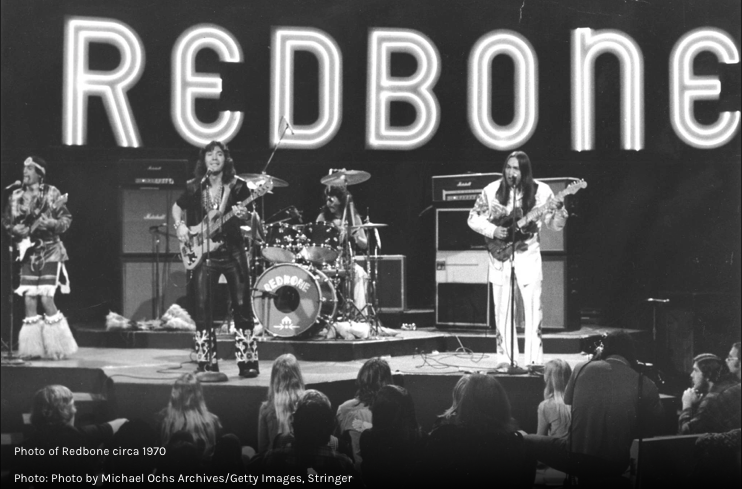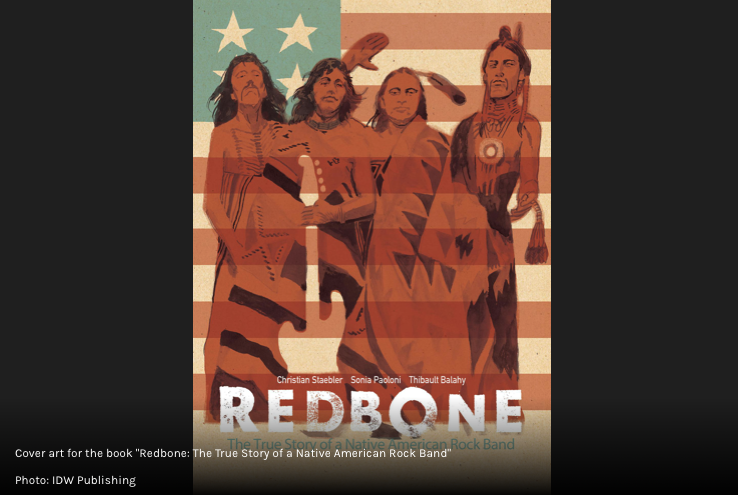Beyond ‘Come and Get Your Love’: Why Redbone matters 46 years later
The band, still the most successful Native American rock group of all time, is now the subject of a new graphic-novel biography.
Reprinted from the Houston Chronicle. Read the original article here.
By Cary Darling
Oct 9, 2020
Redbone, the quartet that gave the world the 1974 top five sing-along hit “Come and Get Your Love,” is the subject of a new biography. But instead of a traditional narrative, the book is a graphic novel/comic book — which might strike some as odd. After all, this is Redbone, not the Avengers.
But, in some eyes, the guys in Redbone, still the most successful Native American rock band this country has produced, are indeed superheroes. So the format of “Redbone: The True Story of a Native American Rock Band” by Christian Staebler, Sonia Paoloni and Thibault Balahy — telling the story of two Fresno, Calif. brothers of Shoshone, Yaqui and Mexican descent, Pat and Lolly Vegas, who became noted L.A. session players and songwriters before moving on to plumb their roots with Redbone — is appropriate. Not all heroes wear capes, and some wear buckskin.
Back in the ‘60s and ‘70s when guitarist Lolly and bassist Pat started, pop music that included “Indian” elements was mostly made by whites in a context that made it either gimmicky (The Electric Indian’s “Keem-O-Sabe”), stereotypical (Cher’s “Half Breed”) or well-meaning but inaccurate (Don Fardon’s “Indian Reservation” which became an even bigger hit for the Raiders.) It’s not that there hadn’t been Native American performers making pop music — guitarist Link Wray (who made the classic 1958 instrumental “Rumble”) and folk singer-songwriter Buffy Sainte-Marie had been active since the ‘50s and ‘60s respectively — but they didn’t enjoy the widespread exposure of their non-Native counterparts.
REDBONE PLAYLIST: For a curated Spotify playlist of Redbone tracks, go to https://open.spotify.com/playlist/3NMOD4cwWs6eu5XLtaWlxA?si=d2oh_Vg9RDy8URzFSRa8wg
Redbone, which also included guitarist/dancer Tony Bellamy (real name Robert Anthony Avila) and original drummer Peter DePoe, changed all that. Before Robbie Robertson got acclaim for his Native-influenced rock with the “Contact from the Underworld of Redboy” and “Music for the Native Americans” albums in the ‘90s, Redbone brought an identifiable Native American consciousness into America’s living rooms in the ‘70s on such TV shows as “Midnight Special”and “American Bandstand” and into the world’s rock venues by sharing bills with Marvin Gaye, Kiss, Steely Dan and Parliament-Funkadelic among others. Indeed, “Come and Get Your Love” not only was a pop hit but crossed over to the R&B charts and even had the kids on “Soul Train”dancing.
Yet, as critical as “Come and Get Your Love” has been to the group’s success — the song was introduced to a new generation in the film “Guardians of the Galaxy” in 2014 and a popular French TV commercial in 2018 — the hooky tune lent the impression that Redbone was just a Top 40 act. It offers few hints of the group’s musical dexterity and influences. (Perceptions of Redbone in Europe were broader as the band had several hits there, including the political “We Were All Wounded at Wounded Knee.”)
Lolly (who died in 2010) and Tony Bellamy (who died in 2009) were underrated guitarists; Jimi Hendrix was a fan. Just listen to Lolly’s funky, light-fingered solo that closes the five-minute version of “Maggie,” a rock-radio hit in 1970.
Listening now to such Redbone albums as “Potlatch,” “Message from a Drum” and “Beaded Dreams through Turquoise Eyes” — with their blends of swamp-rock groove, jazzy swing, old-school soul, Top 40-ready pop, sinewy psychedelia and tribal chants — is like an AM-radio road trip through the South and Southwest in the ‘70s.
As the overlapping signals emerge and subside like waves as you round the Gulf Coast — a little ZZ Top here, a little Neville Brothers there with splashes of Lynyrd Skynyrd, Jerry Reed, George Benson, Wild Tchoupitoulas, early Boz Scaggs and Steve Miller as well as singles from Mississippi’s Malaco R&B label for good measure — it becomes apparent that the name “Redbone” doesn’t just apply to their Native heritage but their musical fusion. “Redbone,” in addition to being the title of a Childish Gambino hit, is also a term that has been applied to a group of specific Louisiana Creoles as well as, more broadly, others of mixed race.
But Redbone the band isn’t consigned to history. Pat, 74, still records and plays under the Redbone name. The group was featured recently in the 2017 documentary “Rumble: The Indians Who Rocked the World.” And, now with the book out, we thought it would be a good time to catch up with Pat along with his daughter, Frankie, who plays in the current line-up and wrote the book’s foreword.
Q. How did the book come about and why a graphic novel?
Frankie: It originally came about through (writer) Christian Staebler. He was a huge fan of Redbone for the longest time. He had reached out to my dad and they had become good friends and then had this idea for this book, telling the history of Redbone…It’s a good step because it will appeal to all different generations, not just people who like to read regular novels. They like to have a visual attached to it. We felt that this was a definitely a good way to approach different levels and ages and people who are interested in the story of Redbone.
Q. Pat, long before Redbone, you and Lolly were known as session players and songwriters (they worked with Phil Spector, Tina Turner, Sonny & Cher, James Brown and many more). You were really young at the time. What was that like?
Pat: They would request us. They would ask for me, specifically, we want them on bass and guitar. That was an honor. I didn’t let it go to my head (laughs).
Q: At that time, people assumed you were Latino.
Pat: A lot people thought we were Italian, Jewish. They didn’t know. We were playing on hit records every week. People knew who we were. We got the respect of the elders, people who had been doing it for years. And I appreciated that so I didn’t mind it.
Frankie: We’re Yaqui and Shoshone and part of our tribe is actually in Sonora, Mexico so there is a little bit of Latin there so it does correlate. I can see why people would assume they were straight Latin.
Q: How did you then decide to do Redbone?
Pat: We were working the nightclub scene in L.A. We were at Gazzarri’s (the Sunset Blvd. club where the Vegas brothers had a residency) and I kind of just had this epiphany and said ‘Lolly, we need to explore our roots.’ What happened was we had to stop playing clubs because everyone considered us a club act. That meant we weren’t going to be making any money. And we were going to have to hole up and rehearse the new material, the new sound. I had a friend who had a house up in the hills and he said you can use my house…We lived there and we rehearsed and rehearsed…CBS (Records) came to see us. He had heard about us and he came up to the house. And we played and he stood up and said, ‘Meet me at CBS Records at three o’clock tomorrow.’ So we meet there and that’s when we signed.
Q: I understand that Jimi Hendrix encouraged you in the new direction?
Pat: One day he walked (into a club) and heard us. He threw off his jacket and ran up onstage, plugs in his guitar and started playing with us, and we jammed for an hour. Afterward, he said ‘I’m joining the group.’…He was behind us all the way.
Q: Did ‘Come and Get Your Love’ stereotype the group as a pop band?
Pat: (Many people) didn’t know who the group was. They just knew it was a beautiful song. They loved it but they didn’t know who the artist was. We did a lot of other hits, like ‘Wounded Knee,’ which was number one in Europe.
Frankie: And ‘Witch Queen of New Orleans’ and ‘Maggie.’ Europe really embraced Redbone for their authenticity and that’s where a lot of their cult following was.
Pat: I think (people) underrated us, absolutely.
Q: Are you surprised after all these years that there hasn’t been another Native American rock band that has done what you did?
Pat: I am surprised. There’s a lot of great Native American players out there. But for some reason or another, the music industry hasn’t found a category for them.
Q: You still perform under the Redbone name.
Pat: I’m still working under the Redbone name. I want to keep the group alive. We did so many great things, I just want to keep it going.
Frankie: There are a lot of hidden tracks from Redbone that have never been released that we are considering putting together sometime soon.
cary.darling@chron.com






